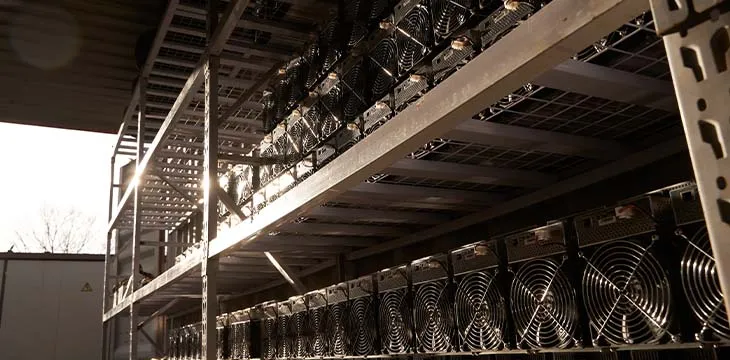|
Getting your Trinity Audio player ready...
|
Like many others in 2022’s digital asset world, Canadian BTC mining firm Bitfarms (NASDAQ: BITF) is “adjusting its HODL strategy” by selling off almost half its BTC reserves. The move reflects the struggles BTC miners have faced in recent weeks to remain profitable as prices sank even below 2017’s all-time high.
CFO Jeff Lucas said today: “While we remain bullish on long-term BTC price appreciation, this strategic change enables us to focus on our top priorities of maintaining our world-class mining operations and continuing to grow our business in anticipation of improved mining economics.”
#Bitfarms Adjusts #HODL Strategy
• Pays down BTC-back credit facility to US$38 million
• Currently holds total of 3,349 BTC
• Daily BTC production of approximately 14 BTC adds further liquidity🔗 More info: https://t.co/xCcIUHkWsU
🚀 $BITF #BTC #BitcoinMining #Blockchain pic.twitter.com/L58siaA99c
— Bitfarms (@Bitfarms_io) June 21, 2022
The firm reportedly mines around 14 BTC daily, and this week’s selloff of 3,000 BTC at current prices will get the company around U.S.$62 million. It recently did a U.S.$37 million equipment financing deal from NYDIG to expand mining operations in Quebec. Half of the 3,000 BTC amount went towards reducing a $100 million BTC-backed credit facility with Galaxy Digital LLC, down to $66 million.
Bitfarms does not offer financial services to the public. It is purely a BTC mining and computing hardware operation with facilities in Quebec, Canada, Washington State, USA, and Villarica, Paraguay. It also has plans to open another location in Argentina. It owns electrical contractor Volta Electrique and focuses on using renewable energy sources, like hydro.
The selloff means Bitfarms is deviating somewhat from its core strategy, which according to CEO Emiliano Grodzki at the start of 2022 was “to accumulate the most Bitcoin for the lowest cost and in the fastest amount of time.” In January it purchased 1,000 more BTC for U.S.$43.2 million. The BTC market price has more than halved since then.
Bitfarms was listed on Nasdaq exactly a year ago when times were happier. That led to a share price peak of U.S.$8.87 in November 2021—currently, it sits at $1.33.
With today's listing of 𝗕𝗜𝗧𝗙𝗔𝗥𝗠𝗦 on Nasdaq, #Bitcoin makes new headlines in Times Square
🚀 $BITF #NasdaqListed #BTC #BITF #BitcoinMining #Blockchain #NASDAQ #NasdaqListed pic.twitter.com/2oBwJ2kvvZ
— Bitfarms (@Bitfarms_io) June 21, 2021
While some replies to Bitfarms’ announcement maintained long-term hope, the majority response was disappointment at a move the company most likely didn’t want to make:
you guys literally bought high sold low….
— hoss 🛡 (@th3hoss) June 21, 2022
https://twitter.com/P4PSMC/status/1539439044182036482
The importance of BTC price
Dramatic price volatility (mostly downward) in 2021/22 has affected all digital/blockchain assets, but the market is dominated by BTC trading. The total market cap for all such assets is around U.S.$941 billion—$390 billion of that is BTC. However, the total also includes stablecoins like Tether (USDT, $66.8 billion) and Binance USD (BUSD, $17.5 billion).
BTC “tradition” so far has been for the coin’s price to double (or more) every four years, covering any financial losses when miners’ block reward halves. With little growth in actual utility in the real-world economy, this has led to accusations the BTC market price is artificially inflated with the mass-printing of stablecoins like Tether.
2022 marked the first time BTC’s price has fallen to levels below the previous bull run’s all-time high. In the past week, it has dropped as low as U.S.$17,760, well below the U.S.$19,665 peak in 2017. Despite bullish optimism in public, this has led to backroom panic in an industry that relies on an ever-growing market price to exist.
The price has since recovered slightly, and at press time, it’s around U.S.$20,746. That price would still fall far below expectations, and many in the BTC world will be praying for a miracle, preferably soon.
Given all this, it’s fair to say most of the digital asset industry is driven by BTC price speculation rather than utility or usage growth. Most BTC holders, even small ones, have adopted a similar strategy to Bitfarms’ —accumulate as much BTC as possible and hang onto it for as long as you can.
With a maximum of around five on-chain transactions per second on the entire network, BTC has struggled to find use cases as a monetary system independent of national currencies. The only “solution” to this problem so far has been to move transactions off-chain to connected networks, like Lightning. This has increased BTC’s technical complexities and led to doubts about security and auditability.
However, BTC’s “HODL” mentality of constant accumulation and price rises—based entirely on hope—have done more damage to the industry. It discourages real-world use even when it’s feasible, and there are endless stories of regret when a user spends BTC in the real economy only to see the price rocket up within a year.
This sort of activity isn’t sustainable long-term and dips like 2022’s remove a lot of the confidence that gains will increase forever. Consumer inflation among national fiat currencies is also reaching new highs, and confidence in government/central bank policies is falling. These are the circumstances in which BTC once promised to prosper. The fact its price is moving in the opposite direction is a dangerous sign.
Watch the BSV Global Blockchain Convention Dubai 2022 Day 1 here:
https://www.youtube.com/watch?v=ggbZ8YedpBE
Watch the BSV Global Blockchain Convention Dubai 2022 Day 2 here:
https://www.youtube.com/watch?v=RzJsCRb6zt8
Watch the BSV Global Blockchain Convention Dubai 2022 Day 3 here:
https://www.youtube.com/watch?v=RzSCrXf1Ywc

 07-12-2025
07-12-2025 





